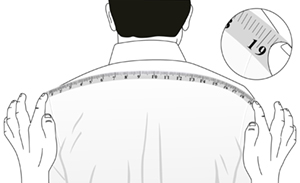How To Measure a Person
Shoulder -- Most critical measurement. Have the person being measured put on a structured shirt or jacket that fits well. Measure across the back, from shoulder seam to shoulder seam, at the widest part. Don’t slouch like this guy!

Jod Waist – Measure at natural waist. If you stand up straight and tip to one side (like doing “I’m a Little Teapot”), the natural waist is the spot you bend at. At or above the belly button. The jod waist is very easy to alter! If you are taking it in or letting it out several inches, you may need to check the seat measurement of the jods to be sure the seat will also fit. Note that the waist measurement of the finished jacket will be several inches bigger than the jod waist, to allow for layers of clothing.

Inseam -- Measured from crotch to floor, with the person standing in socks, feet about 6-8" apart. Make sure the person hikes up his or her pants, so the top of the measuring tape is all the way to the top of the inside leg. Finished jods should measure at least 4" longer. So if your inseam is 30", look for jods that are at least 34". Do not attempt to severely shorten jods, as this will affect the shape of the bell. (A few inches is fine...you can shorten even more if the jod hems have already been let down the maximum amount.)
Nape to Waist -- Measure from the "knob" at the base of neck (or bottom of jacket collar) to natural waist. Nape to waist length determines where the pleats in the back of the jacket will rest. These pleats should hit at your natural waist or slightly below at the top of the hip bone. Pleats that hit too low on your torso will prevent the back of the suit from lying correctly over your backside. As an alteration, nape to waist length can be increased by sewing the jacket pleats closed at the top to achieve the desired back length. Pleats cannot be "moved up" to shorten the back length. (Exception: If the pleats were partially closed at some point, they can be opened back up).

Sleeve Length -- Measure from shoulder seam to base of pinkie. This length will keep your wrists covered when your arms bend and provides an ideal fit. For shirts: If you're wearing a jacket over your shirt, sleeve length is not as critical. The width of the shirt's shoulders will also affect where the cuffs hit. Wider shoulders increase the overall length of the sleeves in terms of length.

How We Measure the Apparel
Coats
Chest: When suit is laid flat, this is the measurement from armpit to armpit, times two for a total circumference. Body measurement should be about 1-1/2" smaller to allow for ease.
Collar to Pleat: Bottom of collar to top of the "side pleats" on the back of the suit.
Jods
Inseam: Measured along the inside seam, from the crotch to the bottom edge of the bell. (This measurement does not include the "point" at the back of the bell.)
Outseam: Measured along the outside seam, from top of waistband to bottom edge of the bell.
Vests
Chest: When vest is laid flat, this is the measurement from armpit to armpit.
Waist: When vest is laid flat, this is the measurement at the narrowest point.
Front length: Measured from the inside shoulder seam (nearest to the neck) to the bottom of the vest point.
Back Length: Measured from the inside shoulder seam (nearest to the neck) to the bottom of the back lining.
Tips:
Vest Length can be altered by adding or subtracting fabric at the shoulder seams, but making changes of more than an inch will affect the depth of the "V", and is not recommended.
Vest Waist/Chest size is easier to alter, as long as the changes are not excessive. There is generally a very small seam allowance, so "letting out" usually involves adding a strip of fabric to the back lining. Vests can be taken in at the sides or back, depending on how the side vents are constructed.
Shirts
Neck: Measured on the collar band, from the middle of the top button to the middle of the top buttonhole.
Chest: When shirt is laid flat, this is the measurement from armpit to armpit, times two for a total circumference.
Shoulder: When shirt is laid flat, this is the measurement across the back from shoulder seam to shoulder seam.
Sleeve length: Measured from shoulder seam to bottom of cuff.
Waist: Measured at the narrowest part of the shirt.
Tips:
The Shirt Neck should measure about 1/2" more than the person's actual neck to allow for a comfortable fit. If the shirt is more than 3/4" to 1" bigger than the person's neck, it will have to be altered if you desire a custom fit. Alteration involves cutting the back of the collar, and putting in a seam to make the collar smaller
